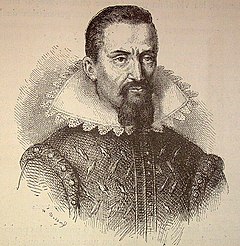1619 in science
Appearance
This article needs additional citations for verification. (December 2009) |
| |||
|---|---|---|---|
| +... |
| 1619 in science |
|---|
| Fields |
| Technology |
| Social sciences |
| Paleontology |
| Extraterrestrial environment |
| Terrestrial environment |
| Other/related |
The year 1619 in science and technology involved some significant events.
Astronomy
[edit]
- Publication of Johannes Kepler's third law of planetary motion in his Harmonices Mundi. He also recognises the duality of convex polyhedra.
- Publication of the Jesuit Giuseppe Biancani's Sphaera mundi, seu cosmographia demonstrativa, ac facili methodo tradita in Bologna.
Biochemistry
[edit]- Lactose is discovered by Fabriccio Bartoletti; the word lactose comes from the Latin word lac which means "milk".
Exploration
[edit]- In North America, the Churchill River is discovered by Danish explorer Jens Munk, and it will be used for over 100 years as a trading route of the Hudson's Bay Company from their fort at its mouth to the interior.
- Frederick de Houtman and Jans van Edel discover the Houtman Abrolhos islands.[1]
Medicine
[edit]- Dermod O'Meara's text on genetic disorders, De Moribus: Pathologia Haereditaria Generalis is published in Dublin,[2] the first medical text published in Ireland.
Metallurgy
[edit]- Sir Basil Brooke produces steel using a reverbatory furnace in Coalbrookdale, England.
Births
[edit]- probable date – Daniel Whistler, English physician (died 1684)
Deaths
[edit]- May 21 – Hieronymus Fabricius, Italian anatomist and embryologist (born 1537)
- September – Hans Lippershey, Dutch lensmaker, credited with inventing the telescope in 1608 (born c. 1570)
- Olivier de Serres, French soil scientist (born 1539)
- Caterina Vitale, Maltese chemist (born 1566)
References
[edit]- ^ Taylor, Isaac (1898). Names and Their Histories: a Handbook of Historical Geography and Topographical Nomenclature. London: Rivingtons. p. 149.
- ^ Moody, T. W.; et al., eds. (1989). A New History of Ireland. 8: A Chronology of Irish History. Oxford University Press. ISBN 978-0-19-821744-2.
